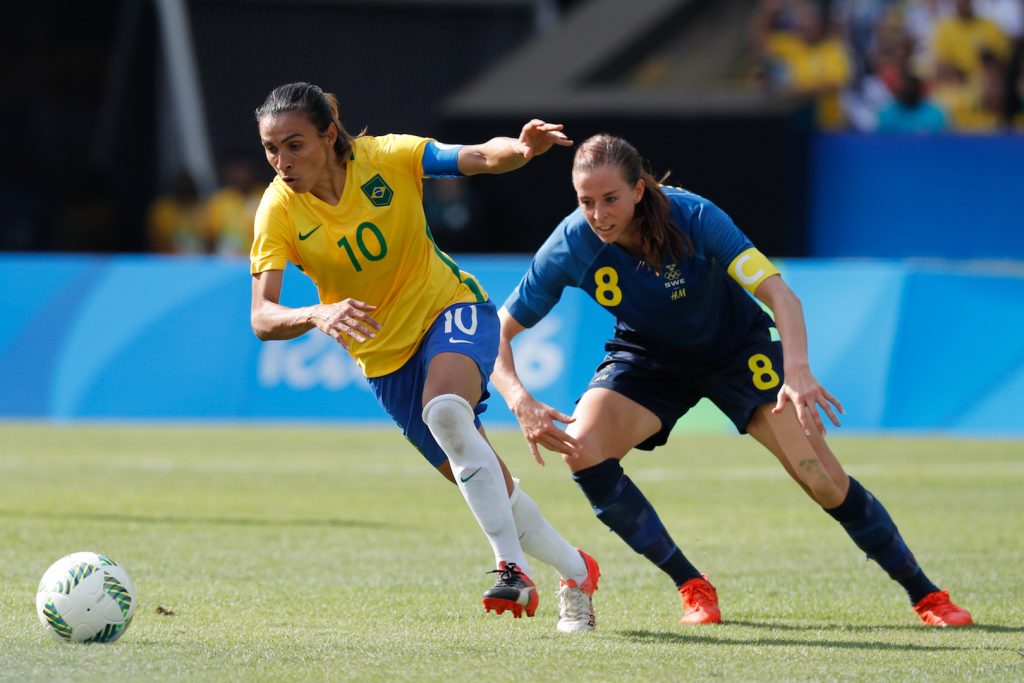By Lise Alves, Senior Contributing Reporter
SÃO PAULO, BRAZIL – As Brazil’s national women’s football (soccer) team advances to the round of sixteen, Brazilians are starting to pay more attention to the sport. Many already know many of the players by name and can name the world’s best football player: not Neymar, Messi or Cristiano Ronaldo, but Marta.

“I don’t understand how the (football) confederation does not give us the same attention (as to men). We have the best in the world,” says the Corinthians women’s football team director, Cristiane Gambare. Gambare is one of a handful of female executives working with women’s teams.
The director explains that for forty years (1940-1980), women were prohibited from playing professional football.
“We are almost forty years behind (everyone else). Without being able to play,” Gambare said during an exclusive interview to The Rio Times.
The lifting of the prohibition, however, did not do much for the division. According to Gambare, the absence of visibility on the part of the mass media, combined with the lack of business investment, opportunity, and planning, have made it very difficult for those teams which try to push the sport forward.
“Unlike the men’s teams, we have had little investment, no planning, no league structure. We were left behind,” says Gambare.
In 1998, says Gambare, Corinthians had a team, but there was no championship for female footballers. “The women practiced, but there was no competition between teams, so it was somewhat disappointing,” explained the director.
Paying players is also a problem. Today, Gambare’s Corinthians is one of the few clubs that can afford to pay their female players.
“Today, only teams in the state of São Paulo are self-sufficient. Only these teams have players who dedicate themselves to the sport 100 percent of the time. In many, many teams, the women have two jobs (playing football and something else to bring home money). They are fighting to keep going, all on their own,” sighs the executive.
The director says that many of the smaller teams also don’t have a physical area in which to practice and “call their own”.
“Even with the best players, without planning, we will get very, very close but… we may be defeated in the end,” admits the director.
In 2016, the South American Football Confederation (CONMEBOL) announced that all clubs which compete in major national and regional championships with a men’s football team would be required to create and maintain a women’s football team by 2019.
The requirement, although benefitting the division, may hurt its image.
“We do not want to be associated with a requirement. No team wants to be “created” because it was required,” notes Gambare.
“We (women’s football) are a product: a good, profitable product that should be invested in,” she says. According to Gambare, women’s football should become self-sufficient within one-and-a-half years.

Gambare says that the requirement also brought to light the lack of knowledge by officials about the women’s game.
“When they first required women’s team (to be created and maintained) along with the men’s teams, Brazilian soccer officials did not even know how many teams were already here, practicing, playing,” she says.
“We are evolving, but we still have a long way to go,” ponders Gambare.
And while there is an underlying negative bias towards women playing football, there is also a lot of discrimination among those working with the players. In 2016, Emily Lima became the team’s first female head coach. Despite her record of seven wins, a draw, and five losses, she was fired after ten months on the job.
She says she was fired because of her gender. “I didn’t want to believe it before, but now I know that was what it was,” she recently said in a TV interview.
Lima now thinks about going abroad to coach. “I need to go where people let me work,” she said.
Even in the larger, more established women’s teams, only a few admit women as coaches, assistant coaches, and trainers. Most of the women listed on the roster are nutritionists, physical therapists, and psychologists.
In the past, the expression “play like a girl” was not a compliment. But that is slowly changing here in Brazil, as Marta and her teammates forge ahead.
“Let us respect the sport. Let the players do their job. Now, there is no turning back,” concludes Gambare.

